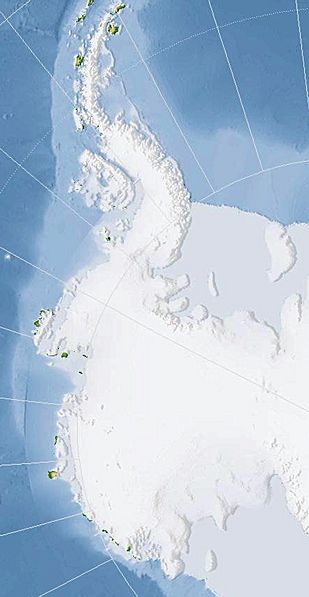West Antarctic glaciers on the retreat
May 20, 2014
Peter Langen (DMI, Polar Portal)
Large parts of the West Antarctic ice sheet is already on its way to collapse according to two studies published this week. However, the scientists concluded that total collapse of the ice sheet will take many centuries to occur. It will be slow at first, accelerating only much later on.
The ice sheet in Antarctica is divided by a mountain range into two parts. The western part rests on ground largely below sea level. This characteristic leads scientists to suspect that it may not be stable. Global warming could lead to glacier retreat, and ultimately the loss of much of the ice sheet. The entire West Antarctic ice sheet contains enough water to raise global sea levels by over 3 m if it were all to melt.
Supply of warm ocean water underneath the floating glacier tongue melts the ice from below. If the first point where the glacier is resting on the bedrock (gounding line) is in an area where the slope is downward toward the glacier, the situation will be unstable. The glacier will retreat until it again reaches a point where the slope is outwards.
Two noteworthy studies have been published this week. A team of scientists from the University of California Irvine and JPL have analysed satellite observations in West Antarctica covering the last 20 years. The other team from University of Washington used a model to project the future of one of the main glaciers in West Antarctica.
The Pine Island, Thwaites, Haynes, Smith and Kohler glaciers all have large floating tongues, allowing warm ocean water to come underneath the glaciers. “Scientists have previously observed warmer waters in contact with the ice. These two new studies show the effects of this on the ice sheet, driving retreat both now and in the future “ said Christian Rodehacke a climate scientist at DMI. “Satellite observations analysed by the group in California clearly show the significant retreat of these glaciers in the last 20 years”.
Irreversible changes
Both studies suggest that the changes in the glaciers are irreversible due to the higher melting rates and the shape of the bed. The bed in this area typically becomes deeper further inland and this means that the glaciers have no stable position.
Global sea level has risen by around 4 cm since 2000 and the ice sheet in Antarctica has contributed around 10 per cent of this. According to the group from the University of Washington, the West Antarctic contribution will slowly increase over time but in the 21st century this will not be more than a few tens of centimetres overall. However, after several hundred years it will most likely increase dramatically. “These results basically confirm other studies showing increasing melt from this sector of Antarctica” said Ruth Mottram a glaciologist at DMI. “However, what is new in this study is the use of much more information about the ground underneath the glaciers. Very few obstacles underneath the glaciers mean that the fast retreat of West Antarctica and sea level rise are plausible.”
In line with the IPCC
The IPCC WG1 report published this year specifically excluded the rapid loss of ice from this region related to the instability of marine ice sheets since there were not sufficiently accurate models or observations available at the time. “This study partially confirms the IPCC sea level estimates.” said Ruth Mottram a contributing author to the sea level chapter of the IPCC report. “The model used by the University of Washington shows only a modest increase in the contribution to sea level over the 21st century with much larger increases likely in the long term. According to the new studies, the retreat will be very difficult to stop”.






